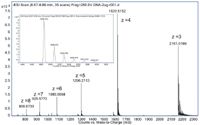Fast Impurity Profiling of Synthetic Oligonucleotides
Agilent Application Note
Moritz Wagner, Zoltan Timar, Edgar Naegele and Gordon Ross, Agilent Technologies, Waldbronn, Germany.
Introduction
Recognition of DNA's and RNA's wide range of biological actions has driven modern biopharmaceutical research into the therapeutic value of oligonucleotides. They are prepared by chemical synthesis and while their size and biological function vary, the requirement for their quality control is the same. The quality control of synthetic oligonucleotides requires a high resolution chromatographic method in order to separate the desired oligonucleotide from fragments generated as a consequence of the automated synthesis and post synthetic process. Liquid chromatography coupled to UV and MS detection allows both relative quantification of the main component and its impurities (UV) and their identification via accurate mass determination (MS).
Results and Discussion
The main component, together with its byproducts, was detected by UV absorbance at 259 nm. Impurities could be determined down to 0.2 % (Figure 1). The base sequences were identified from their accurate mass as discussed below and is annotated. Figure 2 demonstrates that the UV (259 nm) response was linear over the range 160 pg/µL to 100 ng/µL (3.2 ng to 2 µg on-column) and the LLOQ was 160 pg/µL with S/N = 13. This was sufficient to provide quantification of the desired oligonucleotide.

Figure 1: Detection of a synthetic oligonucleotide and its byproducts with a DAD at 259 nm, 2 µg on-column. The annotations show both the peak area percent and base sequence.
The Full Length Product (FLP): 5'-d(GTGTCAGTACAGATGAG-GCCT)-3', elutes at 8.6–8.8 minutes and different charge states can be detected. The calculated average mass using maximum entropy deconvolution was 6486.28 (Figure 3) and the monoisotopic mass calculated by resolved isotope deconvolution was 6483.108. It was possible to confirm the mass of the main product and to assign the impurities as shown in Figure 1.

Figure 2: Calibration curve of full length product (FLP) (UV 259 nm) (Insert: response obtained for the LLOQ 160 pg/uL).
Conclusion
This application demonstrates the separation of a crude synthetic oligonucleotide mixture after synthesis and final cleavage from the solid support. The Agilent 1290 Infinity LC system coupled with the Agilent 6530 Accurate-Mass QTOF LC–MS system can be used to simultaneously quantify and identify impurities down to lower nanogram levels and relative levels of 0.2% of the main compound. While UV detection allows quantification down to a LLOQ of 3.2 ng on-column, the accurate mass measurement allows the highly accurate determination of the average and monoisotopic mass and the base sequence of the synthesized oligonucleotide and process-related impurities.

Figure 3: Maximum Entropy deconvoluted mass spectrum of FLP 5‘- d(GTGTCAGTACAGATGAGGCCT)-3‘, calculated average mass 6486.203 a.m.u.

Agilent Technologies Inc.
2850 Centerville Road, Wilmington, Delaware 19808, USA
tel. +1 800 227 9770 fax +1 302 633 8901
Website: www.agilent.com

Thermodynamic Insights into Organic Solvent Extraction for Chemical Analysis of Medical Devices
April 16th 2025A new study, published by a researcher from Chemical Characterization Solutions in Minnesota, explored a new approach for sample preparation for the chemical characterization of medical devices.



















